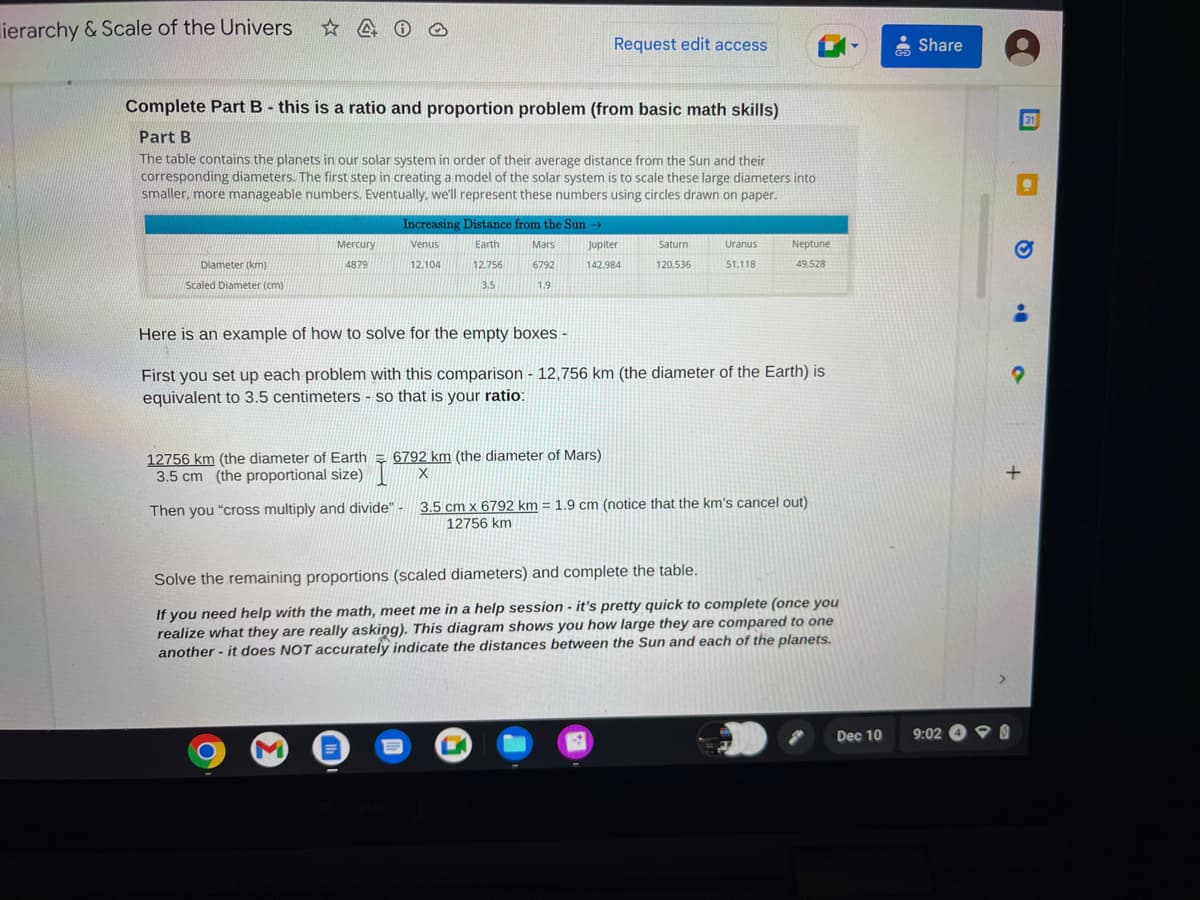Complete Part B - this is a ratio and proportion problem (from basic math skills) Part B The table contains the planets in our solar system in order of their average distance from the Sun and their corresponding diameters. The first step in creating a model of the solar system is to scale these large diameters into smaller, more manageable numbers. Eventually, we'll represent these numbers using circles drawn on paper. Diameter (km) Scaled Diameter (cm) Mercury 4879 Increasing Distance from the Sun → Venus Jupiter Earth 12.756 Mars 6792 12.104 142.984 3.5 1.9 Saturn 120,536 12756 km (the diameter of Earth 6792 km (the diameter of Mars) 3.5 cm (the proportional size) X Uranus 51,118 Neptune 49,528 Here is an example of how to solve for the empty boxes - First you set up each problem with this comparison - 12,756 km (the diameter of the Earth) is equivalent to 3.5 centimeters - so that is your ratio: Then you "cross multiply and divide" - 3.5 cm x 6792 km = 1.9 cm (notice that the km's cancel out) 12756 km Solve the remaining proportions (scaled diameters) and complete the table. If you need help with the math, meet me in a help session - it's pretty quick to complete (once you realize what they are really asking). This diagram shows you how large they are compared to one another - it does NOT accurately indicate the distances between the Sun and each of the planets.
Complete Part B - this is a ratio and proportion problem (from basic math skills) Part B The table contains the planets in our solar system in order of their average distance from the Sun and their corresponding diameters. The first step in creating a model of the solar system is to scale these large diameters into smaller, more manageable numbers. Eventually, we'll represent these numbers using circles drawn on paper. Diameter (km) Scaled Diameter (cm) Mercury 4879 Increasing Distance from the Sun → Venus Jupiter Earth 12.756 Mars 6792 12.104 142.984 3.5 1.9 Saturn 120,536 12756 km (the diameter of Earth 6792 km (the diameter of Mars) 3.5 cm (the proportional size) X Uranus 51,118 Neptune 49,528 Here is an example of how to solve for the empty boxes - First you set up each problem with this comparison - 12,756 km (the diameter of the Earth) is equivalent to 3.5 centimeters - so that is your ratio: Then you "cross multiply and divide" - 3.5 cm x 6792 km = 1.9 cm (notice that the km's cancel out) 12756 km Solve the remaining proportions (scaled diameters) and complete the table. If you need help with the math, meet me in a help session - it's pretty quick to complete (once you realize what they are really asking). This diagram shows you how large they are compared to one another - it does NOT accurately indicate the distances between the Sun and each of the planets.
Applications and Investigations in Earth Science (9th Edition)
9th Edition
ISBN:9780134746241
Author:Edward J. Tarbuck, Frederick K. Lutgens, Dennis G. Tasa
Publisher:Edward J. Tarbuck, Frederick K. Lutgens, Dennis G. Tasa
Chapter1: The Study Of Minerals
Section: Chapter Questions
Problem 1LR
Related questions
Question

Transcribed Image Text:Complete Part C
Part C
Draw each planet on paper using the scaled diameter found in part B. Use a ruler and, if possible, a compass to draw your
planets as shown in the images. Notice that in both of these images the radius (half the diameter) is used to create a
circle.
ANSWER THESE QUESTIONS, IGNORING THOSE LISTED IN THE TASK:
B I U X² X₂
Answer these questions instead of completing the scaled drawings indicated in the instructions - write your answers in complete sentences.
1. Describe the relative distances between the planets. (In other words, as they get further from or closer to the Sun, what do you notice?)
2. How do these distances affect the amount of time it takes each planet to orbit the Sun compared to the Earth (which is 365.25 days - the
length of one year)?
A
15px
Venus
67,000,000
miles
B
3. What do you notice about the size of the planets that are closer to the Sun compared to those that are further away (past Mars)?
e planets
For the third question, look back at the table that you just completed on the scaled diameters.
Use this diagram to help visualize the distances (NOT the sizes) of each planet from the Sun.
Think about how long it would take each of those planets to orbit the Sun - that would be the
length of a year on each of those planets.
Saturn
892,000,000
Dec 10
9:02
a>
+

Transcribed Image Text:ierarchy & Scale of the Univers ✩4
Complete Part B - this is a ratio and proportion problem (from basic math skills)
Part B
The table contains the planets in our solar system in order of their average distance from the Sun and their
corresponding diameters. The first step in creating a model of the solar system is to scale these large diameters into
smaller, more manageable numbers. Eventually, we'll represent these numbers using circles drawn on paper.
Diameter (km)
Scaled Diameter (cm)
Mercury
4879
12756 km (the diameter of Earth
3.5 cm (the proportional size)
Increasing Distance from the Sun →
Venus
12.104
Earth
12.756
Mars
6792
3.5
1.9
M
Request edit access
Jupiter
142.984
6792 km (the diameter of Mars)
X
Here is an example of how to solve for the empty boxes -
First you set up each problem with this comparison - 12,756 km (the diameter of the Earth) is
equivalent to 3.5 centimeters
so that is your ratio:
B
Saturn
120.536
Uranus
51,118
Neptune
49,528
Then you "cross multiply and divide" - 3.5 cm x 6792 km = 1.9 cm (notice that the km's cancel out)
12756 km
Solve the remaining proportions (scaled diameters) and complete the table.
If you need help with the math, meet me in a help session - it's pretty quick to complete (once you
realize what they are really asking). This diagram shows you how large they are compared to one
another - it does NOT accurately indicate the distances between the Sun and each of the planets.
Dec 10
Share
9:02
•
o
31
+
Expert Solution
This question has been solved!
Explore an expertly crafted, step-by-step solution for a thorough understanding of key concepts.
This is a popular solution!
Trending now
This is a popular solution!
Step by step
Solved in 3 steps

Recommended textbooks for you

Applications and Investigations in Earth Science …
Earth Science
ISBN:
9780134746241
Author:
Edward J. Tarbuck, Frederick K. Lutgens, Dennis G. Tasa
Publisher:
PEARSON

Exercises for Weather & Climate (9th Edition)
Earth Science
ISBN:
9780134041360
Author:
Greg Carbone
Publisher:
PEARSON

Environmental Science
Earth Science
ISBN:
9781260153125
Author:
William P Cunningham Prof., Mary Ann Cunningham Professor
Publisher:
McGraw-Hill Education

Applications and Investigations in Earth Science …
Earth Science
ISBN:
9780134746241
Author:
Edward J. Tarbuck, Frederick K. Lutgens, Dennis G. Tasa
Publisher:
PEARSON

Exercises for Weather & Climate (9th Edition)
Earth Science
ISBN:
9780134041360
Author:
Greg Carbone
Publisher:
PEARSON

Environmental Science
Earth Science
ISBN:
9781260153125
Author:
William P Cunningham Prof., Mary Ann Cunningham Professor
Publisher:
McGraw-Hill Education

Earth Science (15th Edition)
Earth Science
ISBN:
9780134543536
Author:
Edward J. Tarbuck, Frederick K. Lutgens, Dennis G. Tasa
Publisher:
PEARSON

Environmental Science (MindTap Course List)
Earth Science
ISBN:
9781337569613
Author:
G. Tyler Miller, Scott Spoolman
Publisher:
Cengage Learning

Physical Geology
Earth Science
ISBN:
9781259916823
Author:
Plummer, Charles C., CARLSON, Diane H., Hammersley, Lisa
Publisher:
Mcgraw-hill Education,